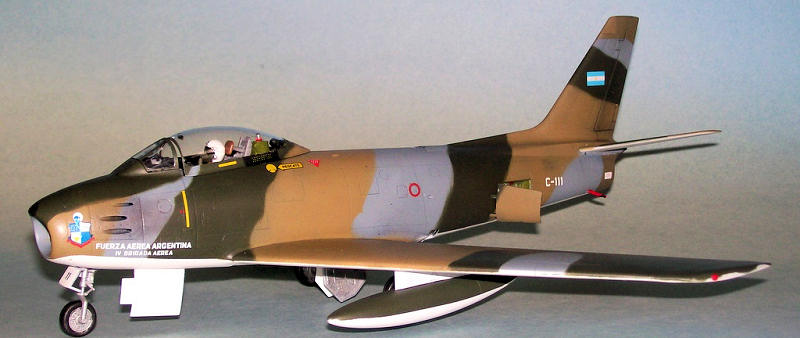
Hasegawa 1/48 F-86F-30 Sabre
| KIT #: | Pt 13 |
| PRICE: | CAD$28.70 |
| DECALS: | Three options |
| REVIEWER: | Pablo Calcaterra |
| NOTES: |
Aerocalcas # 48011, 48002 and 48014 |

| HISTORY |
In
1957, after an impressive display of the Gloster Meteor acrobatic team of the
Air Force in front of Gral Emrick (USAAF), Argentine pilots were invited to
learn to fly Sabres in the
The purchase:
A contract was signed for the first 28
planes that were part of a potentially larger number of planes (December 1958).
These were second hand. They had the -40 wings (slightly longer and with slats).
They were thoroughly inspected in the
The first planes were delivered behind
schedule in 1960 and were C-101, 105, 108, 110, 111 and 112. On
The now called Grupo 1 de Caza Bombardeo
had 3 operational and 1 reserve squadrons. Corean ace Pete Fernandez completed
the training about tactics in
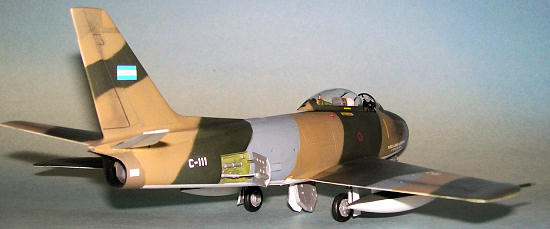 Operational
use:
Operational
use:
The fact that this technology was a
considerable jump when compared to the Meteors, and the lack of spares, meant
that some planes were grounded almost from the very beginning (C-105, 121 and
122) and were cannibalized.
The first plane (C-103) was lost in an
emergency landing in June 1961. The first fatality in a Sabre happened at the
end of an Air Show at the Vta Brigada Aerea, when the experienced ViceCommodore
Correa Arce lost control of the C-118 during an take off acrobatic maneuver.
Seven planes were selected to become the
Acrobatic Squadron called Cruz del Sur (Southern Cross). Planes were painted in
a very attractive red, yellow and blue scheme and they toured the country
intensively (planes were named Alfa, Beta, Alfa Centauro, Gama and Delta)
The First Competition among the American
Air Forces took place in 1962 in El Plumerillo and the winner was the Argentine
team flying their Sabres, followed by the USAAF and
The Air Force also gave support the
operation of their F-86s to the Bolivian Air Force.
Accidents reduced the flight line year
after year. In 1966 cracks in the wing spars were detected. Only 4 planes were
in flying condition. Kits supplied by the
By 1972 the F-86s started to have a
3-colour cammo and the all-metal scheme was not used anymore. These colors
varied throughout the service in the Air Force going from a Dark Green (almost
black) to Dark Green, Dark Grey to Light Blue Gray, and Dark Brown, Green to
Light Brown. Undersides were always white. In 1974 both color schemes where
still co existing. During the first years of the new color scheme, the words “Fuerza
Aerea” were painted in white on the nose. Towards the end of the life of the
Sabres, this text was expanded to “Fuerza Aerea
In 1973 and due to the fact that the
number of available Sabres was greatly reduced, only 2 Squadrons were left.
Then, in 1975 the A4-Cs were purchased and all Sabres constituted II Squadron.
With the Skyhawks in service, the
remaining 13 Sabres struck of charge and sold to
In 1978 only 4 planes were flown in a
constant basis in order to use up all the remaining hours that those planes had,
the rest were grounded with different mechanical problems.
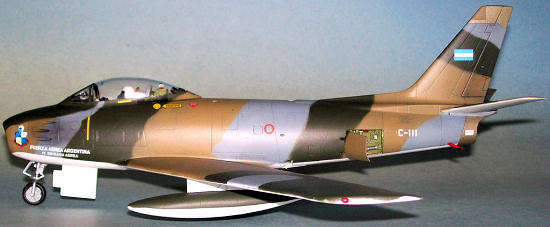 In 1980 the
Squadron was activated again and little by little, all 13 planes were made
operational again. They were the intermediate step in the training of the new
pilots that were to fly Mirages or Skyhawks and several of these flew with
distinction against the British in 1982 (Zini, Mariel, Litrenta in C-130, Paez,
Puga, Arnau, Diaz, Palaver, Cimatti, Mir Gonzalez, Garcia Cuerva, Musso,
Lupianez, Castillo, Demierre, Velasco, Yebra, Lopez, Constantino, Gabari Zoco,
Gonzalez, Castillo).
In 1980 the
Squadron was activated again and little by little, all 13 planes were made
operational again. They were the intermediate step in the training of the new
pilots that were to fly Mirages or Skyhawks and several of these flew with
distinction against the British in 1982 (Zini, Mariel, Litrenta in C-130, Paez,
Puga, Arnau, Diaz, Palaver, Cimatti, Mir Gonzalez, Garcia Cuerva, Musso,
Lupianez, Castillo, Demierre, Velasco, Yebra, Lopez, Constantino, Gabari Zoco,
Gonzalez, Castillo).
Modifications that the Argentine planes
went thru were the replacement of the VHF for a Collins 20B, installation of
VOR/ILS in 1978 and an ADF Collins 60 placed on the tail of the planes in 1983.
Still being used as trainers in the post
Malvinas (
Some of them are in display in different
parks along the country, a couple are in Museums (C-127 at the Air Force’s) and
C-109, 119, 125 and 127 were sold to customers in the
Into “action”:
The planes were used during some internal
conflicts during the early part of the 60’s.
Then, in 1965, the ever-present conflict
with
On
In 1978, when war was only averted by a
storm that prevented Argentine Marines from disembarking on the islands that
were disputed in
Individual history:
C-101: Destroyed in 1968 in an accident.
Pilot ejected
C-102: Destroyed in 1983, pilot ejected
but entangled in the parachute cords, he fell to his death
C-103: Heavily damaged in emergency
landing in 1961
C-104: Flew for the last time in 1986.
4804 hours flown
C-105: Used for spares after 1963
C-106: Accident during landing in 1971.
C-107: Fire on board in 1967, pilot
ejected safely
C-108: Crashed during mock combat against
C-114 but the pilot managed to land with a seriously damaged tail. Pilot ejected
after plane ingested shrapnel during live ammo exercise. 1981
 C-109:
Flew for the last time in 1986. 6027 hours flown. Sold in the
C-109:
Flew for the last time in 1986. 6027 hours flown. Sold in the
C-110: Air collision with C-127 during
combat practice in 1975, pilot ejected safely
C-111: Emergency landing with nose gear
retracted in 1973.
C-112: After several accidents during its
life in Argentina, it was nicknamed “El Asesino” (The Murdered) as the guns
fired accidentally and provoked the death of a Corporal and seriously injured a
NCO. After an emergency landing in 1972 it was
C-113: Crashed in 1962, pilot ejected
safely
C-114: Crashed in the air with C-108,
pilot ejected (1974)
C-115: Crashed due mechanical failure in
1976, pilot ejected
C-116: Destroyed in 1967, pilot ejected
C-117: Run out of fuel and was destroyed
in 1974, pilot ejected
C-118: Destroyed in 1961 shortly after
take off, pilot killed
C-119:
C-120: After an eventful life, suffered a
crack in the spar and fell to the ground taking her pilot to her death in 1986
C-121: After a minor accident it was used
as a source for spares (1963)
C-122:
C-123:
C-124:
C-125:
C-126: Crashed in 1981, pilot ejected
safely
C-127:
C-128: Air collision with C-101 in 1968, pilot ejected safely
| THE KIT |
This is a Korean War Sabre Dash 30. As such, the wings are shorter and the slats are not present. It is typical of Hasegawa or Tamiya, great quality of parts and lots of details.
| CONSTRUCTION |
Being as I said above a Hase, build is
really easy. The engine and air intake were painted in silver. The cockpit,
wheel bays and air brakes have lots of details and I painted it in US Interior
Green, red or black when appropriate, with some dry brushing with silver here
and there. Instrument panel faces were given some drops of Future.
I built the pilot using the correct
helmet for the ones used in the AAF. Minus the head it was glued in his seat. I
left the orange scarf for last in order to paint it with all the other minor
details.
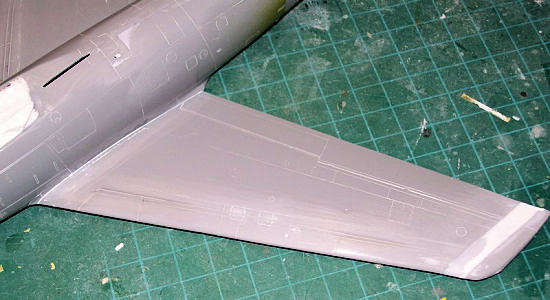 Once the
fuselage halves were joined, I found some small areas where Putty was required.
Once the
fuselage halves were joined, I found some small areas where Putty was required.
Next I put together the wings. Before
attaching them to the fuselage, I cut out the tips, added 2 pieces of plasticard
8 mm wide. These were bent (especially the top one) to follow the contour of the
wing. The wing tips were glued back. It really took lots of sessions of putty,
extra glue and sanding until I got a decent look.
The slats were marked with a knife.
Finally, wings and fuselage were joined. There is very small gap (less of 1 mm)
here and I covered it with acrylic base. Before it got dry, I wiped out the
excess, leaving only this base in the gap.
The drop tanks were modified to remove
the fins. I had to use plasticard and putty to cover the slot thru which the
fins are installed.
Just before starting to paint it, I added
the horizontal tail surfaces.
| COLORS & MARKINGS |
Painting:
I gave the plane a coat of light gray to
check for imperfections and also to give a better surface for the MM Acryl gloss
white paint to adhere.
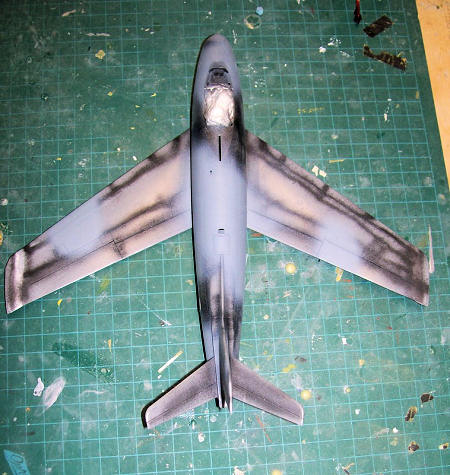 It has been a
long time since I preshaded my kits. I did it again on this plane using black
along all the panel lines.
It has been a
long time since I preshaded my kits. I did it again on this plane using black
along all the panel lines.
Then I started with the Light gray (MM
Acryl 4746 with some drops of black) for the upper surfaces. Using “worms” of
Blue Tac I masked this area and then painted the kit with a combination of two
colours: MM Acryl 4812 and 4728 for the ochre.
After another session of Blue Tac, I
finally painted the dark green (4726) that was made a notch darker using some
drops of black.
In between coats, the panel lines were
dry brushed again in black when they were lost under the previous color.
Some areas in the tail were painted in
burnt metal, same as the exhaust.
I dry brushed sanded black pastel along
moveable areas, guns and some caps.
The entire top surface was given some
coats of Future until I was satisfied with the gloss.
Please note that the demarcation line
between white and cammo on the left side should have been lower in the nose
area…I only realized when I was taking the pictures!
Decals:
I decided to build C-111 because it had a
very interesting story in the Argentine Air Force and also because there are
several pictures of this plane towards the end of her life, which is what I
wanted to represent.
Well, here I had to use 3 sets of decals
from AeroCalcas, as the 2 Sabre sets don’t have all the stencils or details
required for my C-111 (circa 1982). The words “IV Brigada Aerea” were “borrowed”
from their A4-C set 48011.
The numbers are from set 48002. As this
set is one of the first produced by Aerocalcas, they don’t have lots of ink
density and the yellows, for instance, look more like a light green when applied
over a dark background. “C-111”s were the only usable decals from this set.
Hence, all the stencils and flags are from set 48014, which has better ink density.
| FINAL CONSTRUCTION |
I glued the landing gear. The entire
plane was given a coat of satin varnish.
The gunsight and windshield were glued,
as well as the air brakes (should have been in a more “dropped” position),
landing gear doors and the pitot tube (cut to remove the bent tip as the Air
Force planes had a straight version).
 As I had
forgotten to open the holes for the drop tanks located under the wings, I
scratched the white paint and very carefully I glued them using pictures to
properly place them.
As I had
forgotten to open the holes for the drop tanks located under the wings, I
scratched the white paint and very carefully I glued them using pictures to
properly place them.
I painted the scarf in orange (red +
yellow) and glued the head of the pilot.
Very tiny red dots (that mark access to
panels?) were applied with very thin metal tips on a couple of places on the
left side of the fuselage.
The navigation (?) light inside the hood
received a drop of red at the bottom and was then glued. It then seems to be
painted in clear red. Navigation lights on the wing tips were painted in green
and red. Formation lights on the tail were clear and orange (mix red and yellow)
The metallic covers for the intake and
exhaust were painted in bright red.
The landing lights received some drops of
chrome silver and placed under the nose.
Several minor details were added and the
last part to be glued was the rear mirror.
| CONCLUSIONS |
I feel quite happy with the results as I
believe that it represents quite well the look of the Argentine Sabres during
the last years of service.
| REFERENCES |
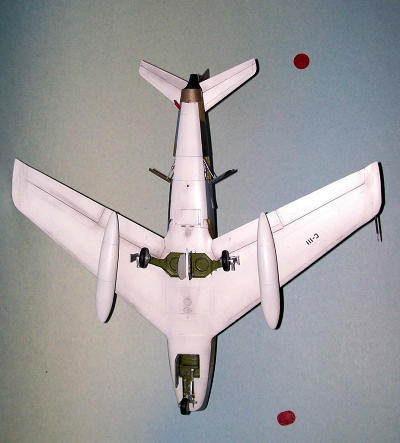 NA F-86 F-30
Sabre, by Atilio Baldini and Jorge Nunez Padin (Serie Fuerza Aerea #16 - 2008).
Excellent reference in which most of the historical part of this text is based.
NA F-86 F-30
Sabre, by Atilio Baldini and Jorge Nunez Padin (Serie Fuerza Aerea #16 - 2008).
Excellent reference in which most of the historical part of this text is based.
NA F-86 F-30 Sabre, by Jorge Nunez Padin
(Serie Fuerza Aerea #6 - 1999)
Escuadrilla Cruz del Sur, by Atilio
Baldini
And my special thanks to Fernando C. Benedetto for his help with the historical part of the text.
December 2010
If you would like your product reviewed fairly and quickly, please contact me or see other details in the Note to Contributors.